Dreams of Wisdom
"Dreams of Wisdom" was performed at the Nicholas Roerich Museum 319 West 107th St., New York, NY on May 17, 2008 by the Charlotte, NC ensemble, Chamber Music at St Peter's. All the paintings that inspired "Dreams of Wisdom" are on display at the museum.
Also on the program was Olivier Messiaen's "Quartet for the End of Time." The free concert was sponsored by the Center for Peace through Culture.
Composer's Note
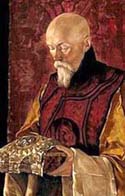 Nicholas Roerich, by Svetoslav Roerich |
"Dreams of Wisdom" is inspired by the life and work of the Russian painter and mystic Nicholas Roerich (1874-1947), one of the most remarkable figures of his time. Trained as a lawyer, but showing early interest in art and archeology, he produced over 8000 paintings during his life, many while on treks into central Asia and the Himalayas. As a young law student he met the future director of the Ballet Russe, Serge Diaghilev, and went on to achieve early success as scenery and costume designer for opera and ballet in Russia and Paris. Roerich's expertise in Russian folk culture led to a collaboration with Igor Stravinsky for "The Rite of Spring" ballet.
During the 1930's Professor Roerich, with his wife Helena embarked on a series of journeys into Asia and the Himalyan regions of Nepal, Sikkim, and Tibet, finally settling in Kulu Valley in northern India. A fervent advocate of the power of art and culture as a force for peace and understanding, Roerich created the Pact and Banner of Peace in1929, for which he was nominated for a Nobel Peace Prize.
"Dreams of Wisdom" is a series musical reflections on five Roerich paintings, from three different decades scored for violin, cello, piano, bass and Bb clarinet and percussion. The intent of the music is not so much to give a musical depiction of the paintings, but rather to express in sound the energetic qualities of the paintings.
All the excerpts below are in mp3 format.
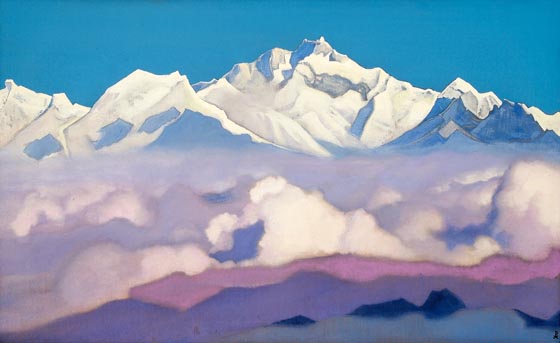
1. Kanchenjunga (1936)
One of Roerich's many Himalayan paintings. Kanchenjunga is the world's
third highest peak. Brilliant white peaks set against a pure blue sky
and surrounded by purple and turquoise clouds. This is the most musically
graphic of the five movements. It opens with repeated piano chords and
sustained notes from the other instruments. Then a faster section with
arching, angular melodies, imitating melodically the jagged outlines of
the mountain peaks. The music moves abruptly and spontaneously from place to place,
finally returning to a state of repose and a restatement of the opening sonorities.
• Excerpt
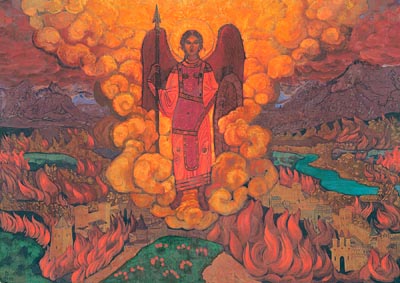
2. The Last Angel (1912)
Painted just before the outbreak of World War I,
this is an apocalyptic vision of coming strife. Roerich also painted a
later, starker version in 1942 during the second World War. The music is
a reworking of sketches composed in 1991 in response to the first Gulf
War. The movement opens with the clatter of Tibetan temple instruments—
cymbals, bells, drums. The piano then intones octave E's, which continue
throughout the movement. A somber theme, first stated by the cello,
slowly unfolds and reappears in various guises and then gradually fades
away into the mist.
• Excerpt
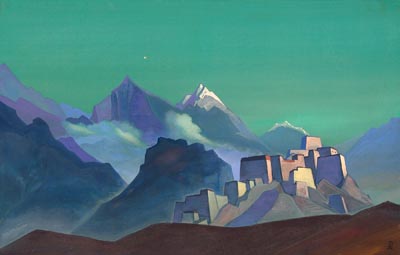
3. Star of the Morning (1932)
One of Roerich's most serene paintings, this
depicts one of the many holy shrines he encountered on his Himalayan
journeys. The music, for piano solo, reflects the quiet stillness of the
scene but also attempts to portray through massive chords the underlying
grandeur and energy of the mountain landscape.
• Excerpt
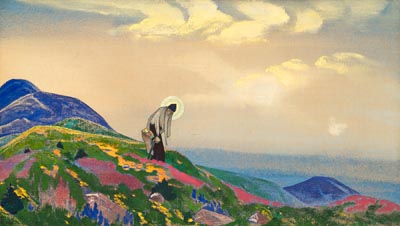
4. St. Panteleimon the Healer (1931)
Roerich did several paintings of saints and holy figures of all
religions. Here the Greek Orthodox Saint Panteleimon, known for his
healing and medicinal expertise, is seen on a mountain meadow gathering
herbs. The music does not describe the painting per se, but rather
explores the healing nature of sound and music. It features a repeating
motive, stated by the clarinet and answered by the piano and cello over
pedal tones in the cello and Tibetan singing bowl.
• Excerpt
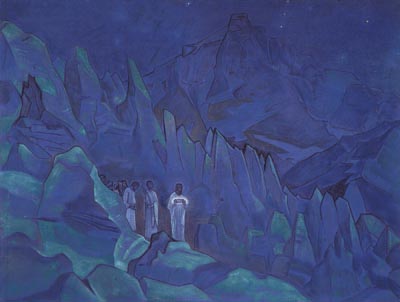
5. Burning of Darkness (1924)
A deeply spiritual work, this painting shows a procession of holy
figures carrying a small box through a mountain pass under a starry deep
blue sky. The casket glows from the inside. According to ancient legends
the box contains a sacred stone which has been brought to earth from a
distant planet for the purpose of raising human consciousness out of the
darkness of ignorance and suffering. Musically, the piece begins in
darkness and chaos with a blur of sound from piano and percussion and
some imploring motives from violin, cello and bass clarinet. A solemn
procession-like section follows. The work concludes with an energetic
scherzo. A persistent repetitive pattern is established by the piano
while the others respond with fleeting, darting gestures, to symbolize
the piercing of darkness with bright shafts of light.
• Excerpt